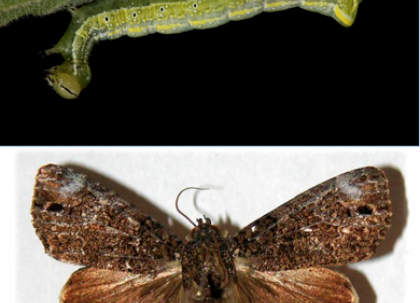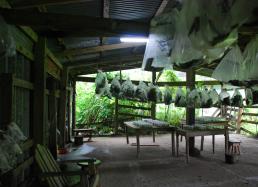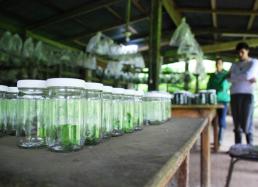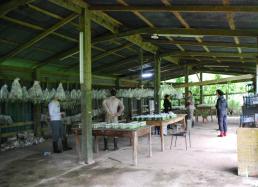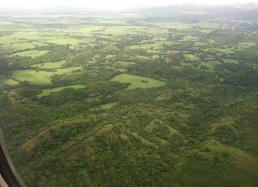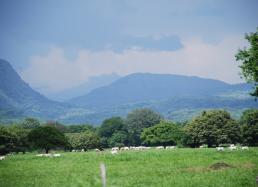Blog #2: Costa Rican Caterpillars
I arrived in Costa Rica on May 22nd, a few weeks in advance of Corrie’s team, to begin four weeks of research at my long-term field site in the Santa Rosa sector of the Guanacaste Conservation Area (ACG for its initials in Spanish). One of the highlights of this particular stint in the forest will be Corrie’s visit. She and I became friends and colleagues in 2003, when I was finishing my undergraduate degree at Harvard, and she was beginning her Ph.D. work there. It was the same year that I had my first experience in the ACG.
In 2003, the summer after my junior year of college, I went down to the ACG to volunteer with Daniel Janzen and Winnie Hallwachs on their Inventory of Tropical Caterpillars, which began nearly 25 years before my arrival. The project seeks to document the diversity of caterpillars for Lepidoptera (butterflies and moths) within the ACG, as well as the diversity of plants those caterpillars eat—and the parasitic wasps and flies that eat the caterpillars.
Butterflies and moths are attractive and charismatic, so they’re often some of the first organisms to be identified in highly diverse tropical forests. But caterpillars are the less noticeable children of their fluttering parents, and there’s often very little family resemblance (see above photo.)
Consequently, although biologists may be able to rattle off names for adult Lepidoptera (and all of the biological information that goes with a name), hand us a caterpillar and we may not be able to tell you anything at all. The goals of Janzen and Hallwachs' ambitious project therefore include connecting the appearance and habits of the caterpillars with those of the adult butterflies and moths.
Importantly, much of the biology of Lepidoptera is connected to the kinds of plants that they eat as caterpillars. Some species of caterpillar may be very picky eaters, dining on only a single species of plant. Others are much less choosy, eating a wide variety of plants in the forest, while several species fall somewhere in between.
Learning what caterpillars eat and where they feed is a first step toward knowing and understanding the vast catalogue of biodiversity that makes up a tropical forest. Caterpillars grow up to become adult butterflies and moths—invaluable pollinators that help perpetuate many different kinds of plants. The webs of interactions in tropical systems are fantastic and complex, and this affects our ability to preserve them: protect the plant, protect the butterfly, and maybe you'll protect that bird over there, too.
To connect the caterpillars to their respective adults, and to determine the dietary breadth of a given caterpillar species, caterpillars are collected with the plant on which they’re found in the forest and brought back to "rearing barns" at the field station, where they’re raised to adulthood (see Photos #1 - #3 below.) If a caterpillar does not continue to grow and eventually pupate (remember the story of The Very Hungry Caterpillar?) by eating the plant it was found on, that caterpillar species may not eat that plant species.
To say more definitively which plants a given caterpillar can and can't eat, Janzen and Hallwachs and their team of talented, locally trained Costa Rican assistants collect thousands of caterpillars every year. Gradually and laboriously, a picture starts to form of the diet of each species, and our understanding of tropical biological diversity grows, as well as our understanding of the web that binds these forest species together.
My experience volunteering with this project was one reason I chose to pursue a Ph.D. in tropical ecology, and, when it came time to choose field sites for studying ant-plant interactions, the ACG topped my list. And so it was that I found myself again in ACG in 2007 to begin dissertation research, and I've been going back at least once a year every year since. When Corrie told me she intended to bring her team down, I was really excited to show them around!
The Field Museum team was due to arrive on the afternoon of June 7th, so I headed out of the field station in Santa Rosa to pick them up at the airport in Liberia, the closest town. Nine years earlier, when I first came to Liberia, it was a tiny airport, mostly used as a connecting point for small planes coming from the capital San José. Since then, it has grown into an international hub, a prime destination for tourists coming to visit the beautiful beaches of the Nicoya peninsula and zipline through the canopies of the surrounding forests.
Driving out of the field station to the highway, I pass through forest of various ages: from relatively old patches where trees are large and thick with epiphytes; to new forest full of spindly, light-loving trees; to a recently burned pasture that represents what much of this area looked like merely thirty years ago. (See “Video Journal #2: Crossing the Costa Rican Countryside” for views of the roadside scenery.)
The Santa Rosa sector of the ACG consists of a type of tropical forest that biologists call seasonally dry, meaning that severe dry seasons alternate with rainy seasons each year. During the dry season, there’s very little rain, and many of the trees endure this prolonged drought by losing their leaves. These leafless trees resemble those of wintertime temperate forests, even though the length of daylight and the temperature vary little here between seasons.
The exceedingly dry conditions that these forests experience each year mean that they’re very easily burned by farmers seeking to clear land for cattle and crops. The result is that seasonally dry tropical forests are highly endangered around the world, and what was once a fairly continuous distribution of this ecosystem along the Pacific Coast from Mexico to Panama now exists only in very small fragments (see Photo #4 below.)
The Santa Rosa sector of ACG is a shining example of what can be done when enough money and dedication exist to stop the fires, which allows the forest to regenerate. Once outside the park, the drive along the highway to the airport includes vistas of green pasture to the west and towering volcanoes, themselves part of the ACG, to the east (see Photo #5 below.)
After arriving at the airport, I spotted Corrie and her group outside customs, and we quickly loaded everyone’s gear into the car for the return trip to the Santa Rosa science station. We’re all really looking forward to begin working together tomorrow, so stay tuned for more blogs from the group!
More from the field later,
Beth

